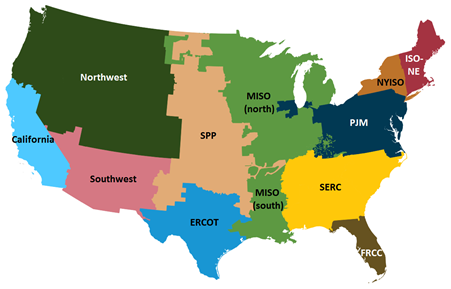BTU.
If that was directed at me, I was talking not about the unit of energy but the transmission networks and regulatory constructs that manage energy here - Regional Transmission Organizations and various other entities, as seen in this map:

It's a mixture of physical power lines not crossing certain areas / state lines, and the way the power markets happen to be setup (i.e. who can buy and who can sell, and from where).
Yes, but NY's power generation still uses fossil fuels imported from elsewhere (probably including Wyoming). The fossil fuels aren't necessarily burned in situ, there's a whole market for them.
The mix is actually quite different between NY and WY, continuing to use them as examples. Compare EIA's profiles
here and
here, which even account for energy imports and exports. They're not exact figures, mind, but work as good ballparks. Most of that natural gas comes from Pennsylvania, mostly likely - natural gas is a bit more tricky to transport than coal, and coal is increasingly not used much in the U.S.
Furthermore, these days the transportation sector is actually the largest source of GHG emissions nationwide (though not the case in every state yet). Comparing the consumption figures again from EIA, NY uses 10 times more energy for transportation, but has over 30 times the population. [Edit: It's a good chance that much of WY's transportation emissions are pass-through truck freight, though.]
Google Scholar is your friend:
Probably a quirk of Google's relentless 'personalization', but your linked search isn't turning up the quoted article for me. That said, most of the ones that turn up are in a similar vein. It's interesting stuff, though unfortunately faces limits in terms of area needed for the sheer number of people that exist these days / in the not-so-distant future.

 Author
Topic: AmeriPol thread (Read 4443642 times)
Author
Topic: AmeriPol thread (Read 4443642 times)
